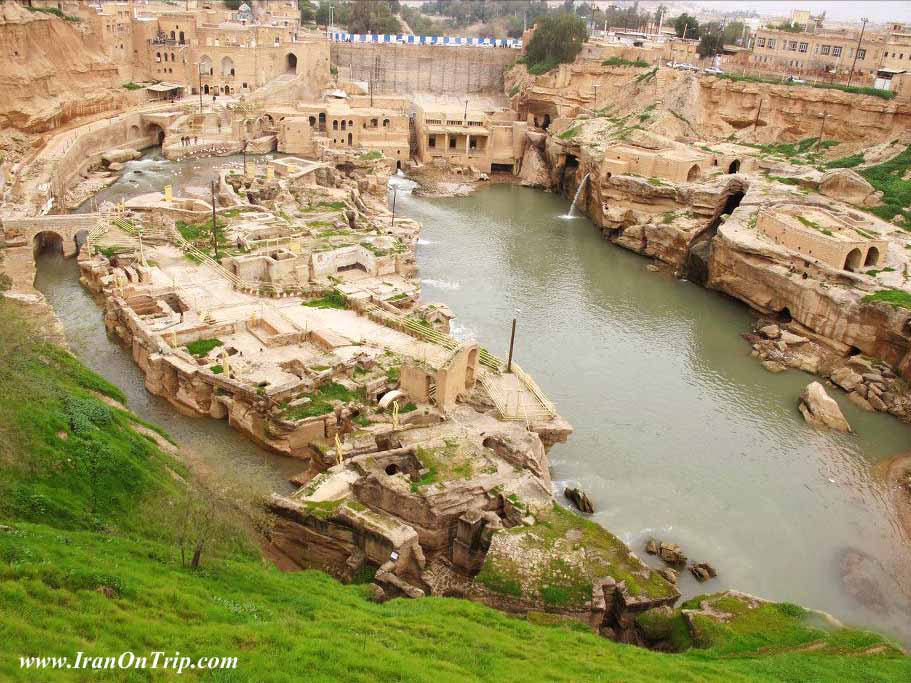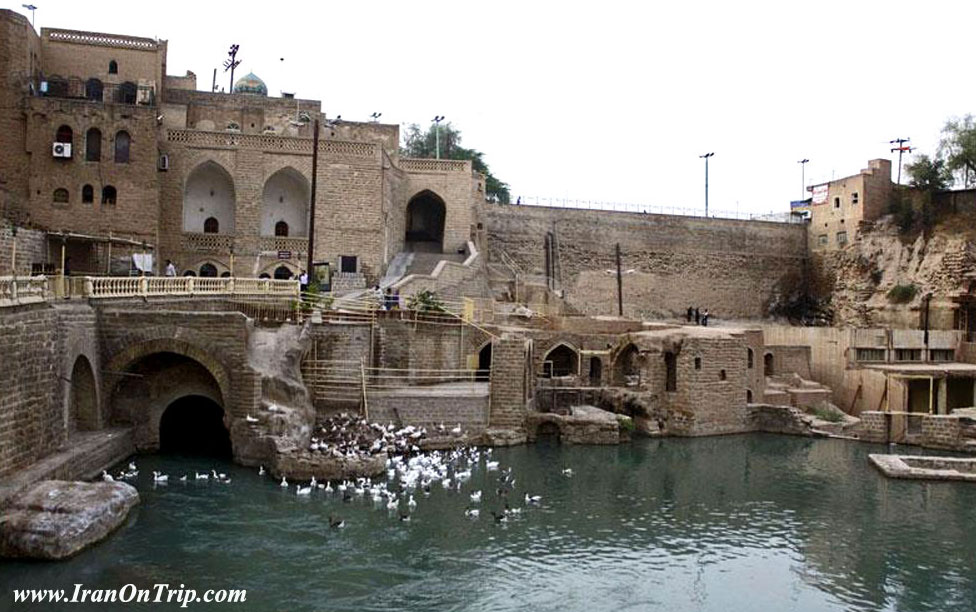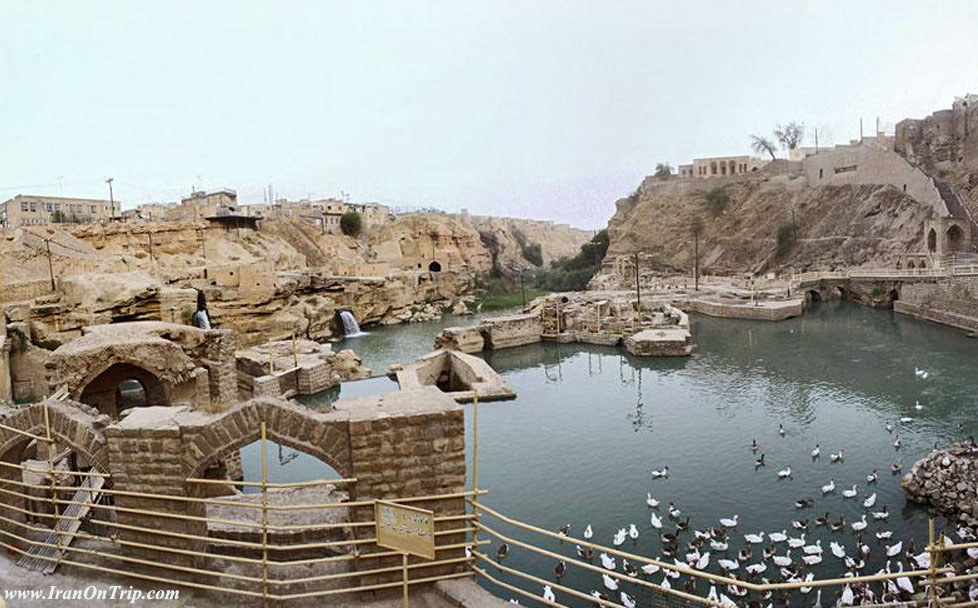Shushtar Historical Hydraulic System

Shushtar Waterfalls: UNESCO Historical Site: Shushtar Waterfalls These waterfalls are the masterpieces of engineering at the time of ancient Iranians. The entire collection includes waterfalls, dams, bridges, basins, mills, etc. The waterfalls are planned and dug into the rocks on the new course of water chosen by the ancient engineers. For more than 1600 years, these mills
Shushtar Historical Hydraulic System

Shushtar, Historical Hydraulic System, inscribed as a masterpiece of creative genius, can be traced back to Darius the Great in the 5th century B.C. It involved the creation of two main diversion canals on the river Kârun one of which, Gargar canal, is still in use providing water to the city of Shushtar via a series of tunnels that supply water to mills. It forms a spectacular cliff from which water cascades into a downstream basin. It then enters the plain situated south of the city where it has enabled the planting of orchards and farming over an area of 40,000 ha. known as Mianâb (Paradise). The property has an ensemble of remarkable sites including the Salâsel Castel, the operation centre of the entire hydraulic system, the tower where the water level is measured, damns, bridges, basins and mills. It bears witness to the know-how of the Elamites and Mesopotamians as well as more recent Nabatean expertise and Roman building influence.
Outstanding Universal Value
Brief Synthesis

The Shushtar Historical Hydraulic System demonstrates outstanding universal value as in its present form, it dates from the 3rd century CE, probably on older bases from the 5th century BCE. It is complete, with numerous functions, and large-scale, making it exceptional. The Shushtar system is a homogeneous hydraulic system, designed globally and completed in the 3rd century CE. It is as rich in its diversity of civil engineering structures and its constructions as in the diversity of its uses (urban water supply, mills, irrigation, river transport, and defensive system). The Shushtar Historical Hydraulic System testifies to the heritage and the synthesis of earlier Elamite and Mesopotamian knowhow; it was probably influenced by the Petra dam and tunnel and by Roman civil engineering. The Shushtar hydraulic system, in its ensemble and most particularly the Shâdorvân Grand Weir (bridge-dam), has been considered a Wonder of the World not only by the Persians but also by the Arab-Muslims at the peak of their civilisation. The Gargar canal is a veritable artificial watercourse which made possible the construction of a new town and the irrigation of a vast plain, at the time semi-desert. The Shushtar Historical Hydraulic System sits in an urban and rural landscape specific to the expression of its value.
Criterion (i): The Shushtar Hydraulic System is testimony to a remarkably accomplished and early overall vision of the possibilities afforded by diversion canals and large weir-dams for land development. It was designed and completed in the 3rd century CE for sustainable operation and is still in use today. It is a unique and exceptional ensemble in terms of its technical diversity and its completeness that testifies to human creative genius.
Criterion (ii): The Shushtar Historical Hydraulic System is a synthesis of diverse techniques brought together to form a remarkably complete and large-scale ensemble. It has benefited from the ancient expertise of the Elamites and Mesopotamians in canal irrigation, and then that of the Nabateans; Roman technicians also influenced its construction. Its many visitors marvelled at it and were in turn inspired. It testifies to the exchange of considerable influences in hydraulic engineering and its application throughout antiquity and the Islamic period under the various Iranian dynasties.
Criterion (iii): Shushtar is a unique and exceptionally complete example of hydraulic techniques developed during ancient times to aid the occupation of semi-desert lands. By diverting a river flowing down the mountains, using large-scale civil engineering structures and the creation of canals, it made possible multiple uses for the water across a vast territory: urban water supply, agricultural irrigation, fish farming, mills, transport, defence system, etc. It testifies to a technical culture dating back eighteen centuries serving the sustainable development of a human society, in harmony with its natural and urban environment.
Integrity and Authenticity
The integrity of the hydraulic footprint is good, but its functional integrity compared with the original model is only partial and reduced, notably for the dams; it remains good for irrigation and water supply. The authenticity of elements reduced to archaeological remains is certain, but has been affected by 20th century works and materials so far as the civil structures and sites still in use are concerned. Efforts directed to the restoration of attributes that demonstrate authenticity must be pursued.
Management and protection requirements
The components of the management plan are satisfactory, but they need to be improved in terms of the interpretation of the sites and the involvement of the local population.
Historical Description
[in French only]
Les premiers systèmes hydrauliques d'irrigation à partir de canaux attestés dans la région remontent à la civilisation des Élamites (région de Chogha Zanbil), notamment au XIIIe siècle av. J.-C. Ils ont probablement été eux-mêmes influencés par les travaux d'irrigation à grande échelle entrepris en Mésopotamie par les Sumériens à partir du IVe millénaire av. J.-C.
Darius le Grand, souverain achéménide du début du Ve siècle av. J.-C., fit réparer les systèmes d'irrigation élamites et la création du canal Dâriun lui est attribuée, à l'ouest de l'actuel site de Shushtar. Des vestiges archéologiques proches du canal tendraient à le confirmer. Darius et les souverains achéménides sont par ailleurs connus pour leurs travaux hydrauliques, notamment en Égypte. La construction du grand déversoir de Shâdorvân barre la rivière Kârun et permet son franchissement. Cette oeuvre audacieuse a été réalisée par le second empereur sassanide, Shapur, au milieu du IIIe siècle apr. J.-C.
La présence de prisonniers romains sur le chantier du barrage, dont l'empereur Valérien lui-même, est évoquée par une source perse du XIIe siècle. Elle indique aussi que le constructeur de Shâdorvân serait l'ingénieur et architecte d'origine romaine Andimeshk. Une influence du génie civil romain semble attestée par certains aspects du système hydraulique alors mis en place. Il est également vraisemblable que les travaux hydrauliques de Petra, par les Nabatéens au Ier siècle apr. J.-C., aient influencé le projet de dérivation d'une rivière dans un site rocheux en utilisant un barrage et en perçant un tunnel.
Complété par la prise d'eau monumentale Mizân, en amont de Shâdorvân, et le canal de Gargar, l'ensemble hydraulique alors refondé et amplifié est destiné à alimenter en eau la ville nouvelle de Tustar, plus tard dénommée Chouster ou Shushtar, et à irriguer la vaste plaine semi-désertique au sud, le long des derniers contreforts montagneux, pour une mise en valeur agricole systématique, notamment par la constitution de vergers.
Les sources arabo-musulmanes attestent la réputation de l'ouvrage d'art de Shâdorvân, qualifié de Grand déversoir et de Merveille du monde. Bien qu'il n'y ait pas de trace explicite pour les périodes plus anciennes, il est permis de penser qu'il s'agit d'une tradition remontant aux origines perses de la construction. L'ouvrage et le système hydraulique associé ont marqué l'esprit des visiteurs au fil des siècles, jusqu'aux Européens au XIXe siècle.
Durant la période islamique, les différentes dynasties de l'Iran ont entretenu avec soin le système hydraulique de Shushtar, comme un élément essentiel de l'aménagement du territoire. Ils ont fait d'importants travaux d'entretien et parfois des travaux complémentaires, comme les Safavides (1500-1700) puis les Qadjar (1779-1925), pour le pont barrage de Gargar ou le Grand déversoir de Shâdorvân. La zone des moulins, de son pont-barrage et des tunnels a été aménagée depuis la période des origines au moins jusqu'au XVe siècle, puis à nouveau aux XIXe et XXe siècles.
Source: Advisory Body Evaluation
.....
.....
.....

.jpg)



























